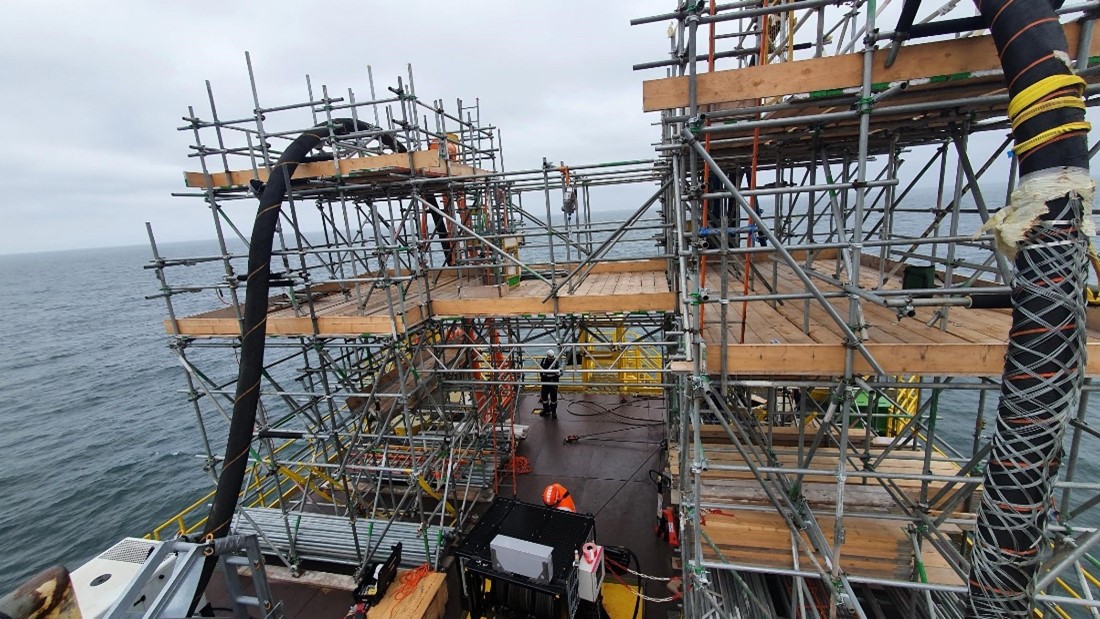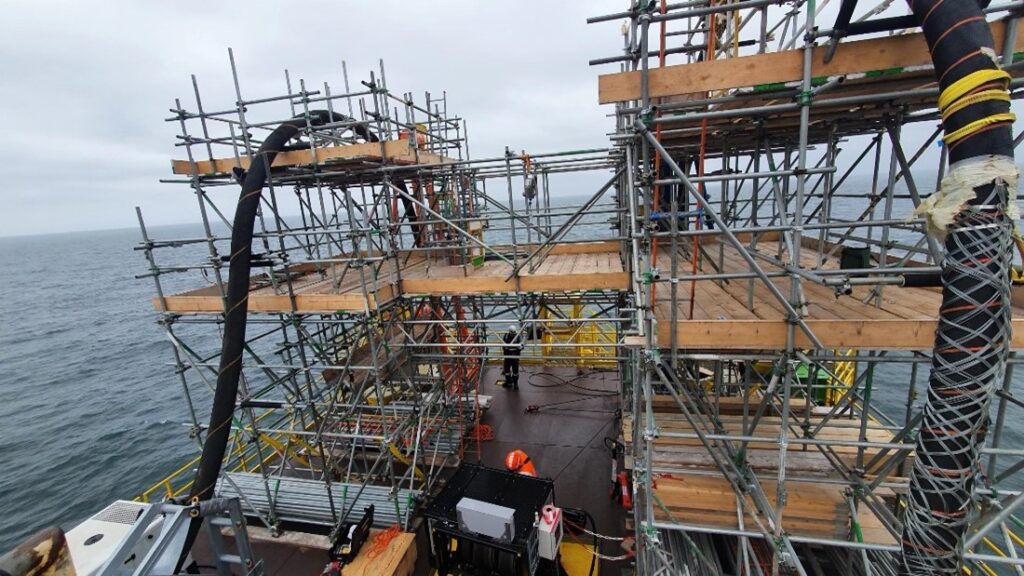Date: 2020 – Current
Location: United Kingdom, East Coast
Client: Orsted
Windfarm Size: HOW02 1.32GW, 165 turbines, 1 Offshore Substation, and 1 Reactive Convertor Station
Scope of Work: Scaffold Design – Access Scaffolding – Site Support – Crane Operators – Balance of Plant Technicians – Slinger Signallers – LOLER Inspectors – Riggers – QHSE Advanced Rescue Team – PPE Inspectors – Viking Chute Removal team
BGB supplying access solutions for the entire Hornsea 2 Project from the Onshore Substation in Killing Holme, to Transition Joint Bay at Horseshoe Point in Grimsby, to the Export Cable Support before we created the largest vertical pull quadrant that Boskalis had ever carried, to the installation of the topside and RCS for the Worlds Largest Offshore Windfarm.
In the May of 2020, BGB were awarded the scaffolding scope for the scaffolding and access works to the Hornsea Two Onshore Substation where we applied our services to created designs and safe access and capsulation for the terminations of the Outdoor Sealing End Structures, Gas Insulated Structures and Shunt Reactors. These scaffolds were designed to enable the pull in of the cables from the ground level up 18m in height. Due the sensitivity and extremely high costs of the cables, we have to create a weather tight contained scaffolding environment to prevent any damage to the cables.
Transition Joint Bay
As we followed the route of export cable from the onshore substation to the TJB, this is where the jointing of the onshore Export Cables meet the offshore Export Cables.
We were tasked to create weather proofing and access to protect the cables and a safe working area for the cable jointing team.
Export Cable Quadrants
Due to the installation of the Topside being delayed, this caused Orsted to change the pull in process due to have previously planned to complete the cable pulls using the topside structure. Orsted and the Cable Supply and installation teams started discussions to arrange a potential solution to this situation and contacted BGB to find a solution to help support the cable pull. Between all stakeholders we created a scaffold quadrant to support the cable pulls of 2 no. Export Cables. The scaffold was a multi- purpose scaffold which was used to first act as support quadrant to assist with the cable pull phase where we would support the cable at 0.5m intervals and they would sit onto, purpose made nylon rollers which allowed the cable to rollover the scaffold and ensure the cable was always supported to prevent any damage to the cable and cause this to be compromised.
Once the cable had been pulled into position, the scaffold would then need to have support beams in place above head height which would allow rigging to be placed on and then the single core cable would be lifted above then the cable would be stripped in the 3 cores. Then the sacrificial components of the scaffold would be removed and the cable would be lowered to sit on the newly installed nylon rollers and into a position that ensured the MBR of the cable was not compromised.
The scaffold had to stay in position to support the cable while the topside was installed, this required the scaffold to be dismantled to 2.3m in height and no vertical upright could be any higher than this otherwise the topside would clash with the scaffold while being installed. This was all included within the design process and carried out to precision from our team on site, ensuring that clashes with scaffolding and the Topside installation were avoided. This again highlights that scaffolding is such an integral part to the critical path of the project, the potential cost implications of having a heavy lift crane held up on the project due to delays from scaffolding installed incorrectly would have resulted in financial penalty enforcements.
Topside for OSS and RCS
Once the Topside was installed, we continued with the scaffold services on the project where we supplied access to enable the OSS Commissioning teams to remove all sea fastenings and a variety of other works such as access to the transformers, shunt reactors, overhead gantry cranes to name a few.
For the Export Cables routing and terminations, this was to be carried out by 2 separate companies. So to prevent duplication of scaffolding, we engaged with all parties and created a large Birdcage (Dancefloor) type scaffold which encompassed the entire cable deck of the RCS. With this type of planning, we were able to use this scaffold for multiple purposes such as cable pull in of 3rd Export Cable, routing, testing and terminations for numerous contractors. Alongside this, with some minor alterations we were able to utilise this to allow for the cleaning of all the stainless steel which had started to be contaminated with fly rust.
In total of the Hornsea Project, we supplied over 100 tones over scaffolding, erected 685 scaffolds, amassed 60,000 project hours with 0 LTI’s as well as carrying out On site safety assessments by our QHSE team. Delivering this project during the Covid Pandemic was a challenge that BGB delivered to precision with zero time delays on the project. This showcases the wealth of experience, professionalism, dedication to project delivery, safety and most importantly our commitment to continue with our partnership with Orsted. Since 2017 BGB have played an integral part in delivering access and site support for every offshore Windfarm have completed across the world and this is a partnership which want to continue to build on with a global scale.

